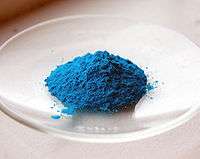Copper aspirinate
 | |
4.png) | |
-aspirinate-3D-balls.png) | |
| Names | |
|---|---|
| IUPAC name
dicopper 2-acetyloxybenzoate | |
| Other names
tetrakis-μ-acetylsalicylato-dicopper(II), copper(II) aspirinate, cupric acetylsalicylate, cupric aspirinate, cupric aspirin complex | |
| Identifiers | |
| 23642-01-5 | |
| Jmol interactive 3D | Image |
| PubChem | 92244 |
| |
| |
| Properties | |
| C36H28Cu2O16 | |
| Molar mass | 843.69g/mol |
| Appearance | Bright blue crystalline solid. |
| Melting point | 248 to 255 °C (478 to 491 °F; 521 to 528 K) (decomposes) |
| Pharmacology | |
| Pharmacokinetics: | |
| 8.67 h (Human)[Ref#2] | |
| Hazards | |
| US health exposure limits (NIOSH): | |
| PEL (Permissible) |
TWA 1 mg/m3 (as Cu)[1] |
| REL (Recommended) |
TWA 1 mg/m3 (as Cu)[1] |
| IDLH (Immediate danger |
TWA 100 mg/m3 (as Cu)[1] |
| Related compounds | |
| Other cations |
Zinc aspirinate, Aluminium aspirinate |
| Related compounds |
Aspirin |
| Except where otherwise noted, data are given for materials in their standard state (at 25 °C [77 °F], 100 kPa). | |
| | |
| Infobox references | |
Copper(II) aspirinate is an aspirin chelate of copper(II) cations (Cu2+). It is used to treat rheumatoid arthritis.
Preparation
Copper aspirinate can be prepared by several methods. In one route of preparation, an excess of acetylsalicylic acid is dissolved in aqueous sodium carbonate. Sodium hydroxide is not suitable for this purpose, because it will hydrolyse acetylsalicylic acid (ASA) into salicylic acid and sodium acetate.
- 2 HC9H7O4 + Na2CO3 → 2 NaC9H7O4 + CO2↑ + H2O
The resulting solution is then filtered to remove any undissolved acetylsalicylic acid and is mixed with a solution containing Cu2+ cations (copper(II) sulfate is suitable), precipitating bright blue crystals of copper aspirinate immediately. The crystals can then be filtered from solution, washed, and dried. An excess of acetylsalicylic acid is used in the first step, because it eliminates the possibility of unreacted carbonate anions precipitating the copper in this step.
- 4 NaC9H7O4 + 2 CuSO4 → C36H28Cu2O16↓ + 2 Na2SO4
Medicinal use
Copper aspirinate has been proven effective as a treatment for rheumatoid arthritis.[2] A pharmacokinetic study in healthy human volunteers supports its enhanced efficacy as compared with aspirin [3] The studies on animal models suggest that copper aspirinate is very promising in treating against thrombotic diseases and it has all the prospects of success in becoming an antithrombotic drug that prevents and treats thrombotic diseases in humans.[4]
Other uses
The use of copper aspirinate as a pigment in PVC and Polystyrene has also been investigated.[5]
External links
Footnotes
- 1 2 3 "NIOSH Pocket Guide to Chemical Hazards #0150". National Institute for Occupational Safety and Health (NIOSH).
- ↑ "Rheumatoid Arthritis (RA)". Copper Development Association. June 2000.
- ↑ MS Iqbal, M Sher, H Pervez & M Saeed (2008). "Pharmacokinetic Study of Copper (II) Acetylsalicylate" Biol. Trace Elem. Res. 124:283–288. doi:10.1007/s12011-008-8146-3
- ↑ Weiping Liu,corresponding author1 Huizhou Xiong, Yikun Yang Ling Li, Zhiqiang Shen, and Zhihe Chen (1998). "Potential Application of Copper Aspirinate in Preventing and Treating Thromboembolic Diseases". Met Based Drugs. (Hindawi Publishing Corporation) 5 (3): 123–126. doi:10.1155/MBD.1998.123. PMC 2365110. PMID 18475833.
- ↑ Allan, J R; A Renton; W E Smith; D L Gerrard; J Birnie (1991). "A Study of the Performance of Bis(acetylsalicylate) Copper(II) and the Cobalt(II), Nickel(II) and Copper(II) Complexes of Pyridine-3,4-dicarboxylic Acid as Colouring Materials for Poly(vinyl chloride) and Polystyrene". Eur. Polym. J. 27 (7): 669–672. doi:10.1016/0014-3057(91)90155-H.